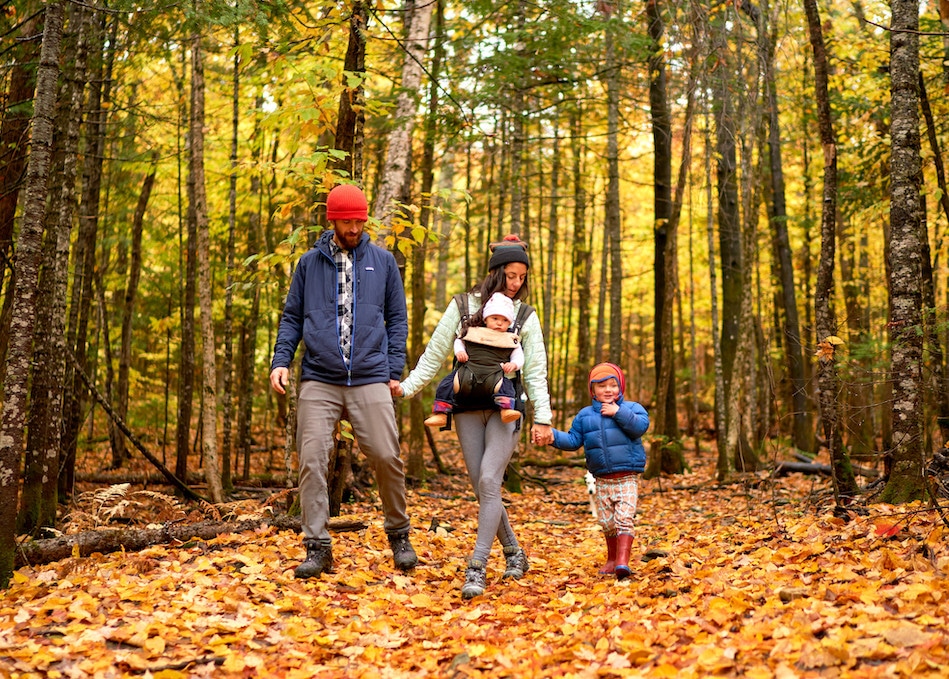
A young family takes an autumn hike through Maine’s Aroostook State Park. Photo courtesy of Visit Maine
By Mark Orwoll
Fall just knocked on our door and didn’t wait for an invitation to enter. Like it or not, Autumn arrives this week. In the Northeastern United States, which includes the six New England states of Maine, New Hampshire, Vermont, Massachusetts, Connecticut and Rhode Island plus the Empire State of New York, the days grow shorter as temperatures slowly decline.
Window-unit air-conditioners disappear from homes in villages and towns, as residents embrace the cooler, crisper days. Leaf-blowers eviscerate the quiet of our once-placid Sunday afternoons while “Back-to-School” sales are announced in newspapers and shopfront window banners with huge red lettering and exclamation marks. And, of course, Starbuck’s trots out the seasonal pumpkin-spice lattes.
Autumn officially begins on September 22, but we who live in the Northeast begin preparing for the season the moment summer tourists start returning home at the end of August.
From the Victorian seaside charms of Cape May, New Jersey, to remote Easton, Maine (pop. 1,287), on the edge of Aroostook State Park and the Canadian border, folks are pulling boxes out of their attics to retrieve nearly forgotten woolens. Itchy scarves, cashmere sweaters and heavy boots are called back into service in the war against the coming winter. Back into storage go the sleeveless blouses, Hawaiian shirts and rubber sandals of summer.
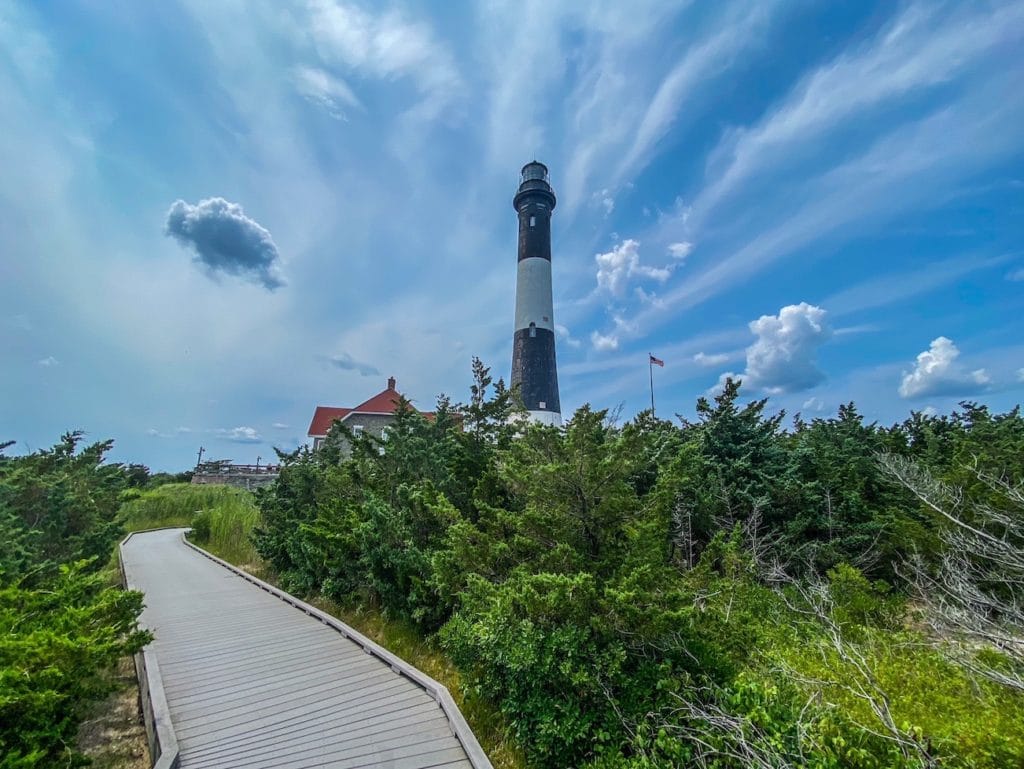
A soothing corona of cirrus clouds complements the lighthouse on Fire Island. Photo by Leon Gurinski courtesy of the Fire Island Lighthouse Preservation Society.
These days, I’m a gentleman of leisure, still working but no longer on the clock. When I was a full-timer in the work force, fall meant the end of the celebrated “summer Fridays,” as well as the unofficial, not-so-secret “late-arriving Mondays.” But with more time on my hands, I’ve begun to enjoy the Northeast autumn in ways I never before could.
The beach, for instance. Whether it’s Cape Cod or the Jersey Shore, the seaside dunes are desolate come September. The lifeguard stations are shuttered, the summer crowds have scattered and many of the high-season stores and cafés have closed. But I swear, the air is cleaner and the sand is still warm, somehow holding in the heat of July. Plus—and this is very important—you can let your dog run free, without a leash. (But please check local regulations—or at least check for the presence of someone with a badge who might yell at you and your pet.)
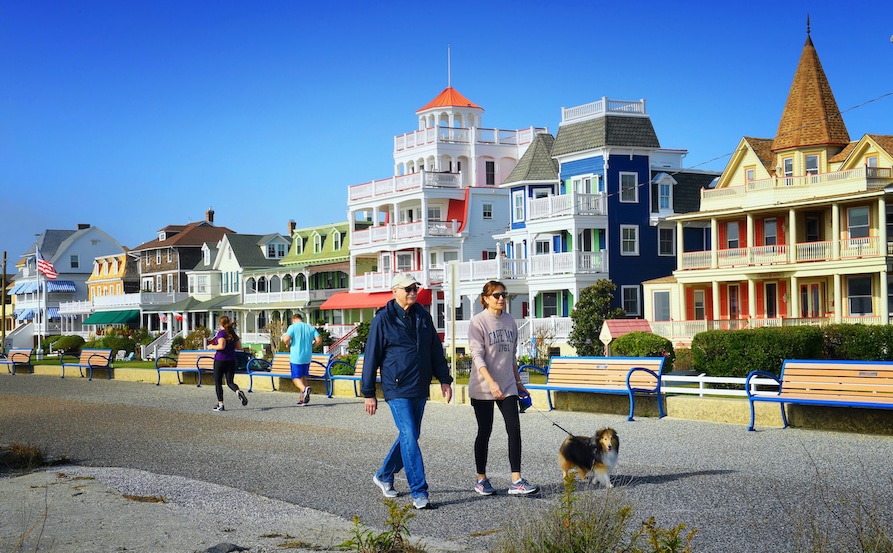
On the Jersey shore in Cape May only the trees change colors. The century-old buildings facing the ocean retain their brilliance, perhaps because there are fewer people and cleaner air. Photo by Craig Terry/Cape May County Tourism
The beach in autumn is even better if you have a buddy with a house there—say, in the hamlet of Kismet, Fire Island, off Long Island, New York. Or, failing a friend there, try the Fire Island Boatel. There are no streets, no cars, and, in the fall, no people in Kismet. At least, not to speak of. To get there, book the 6 p.m. Friday ferry from the 19th-century resort town of Bay Shore so you can enjoy a blazing sunset behind the Robert Moses Bridge and the Fire Island Lighthouse, which has guided sailors since 1858. And don’t forget to pack along a case of beer, hot dogs, and buns on the ferry crossing, because Kismet Market closes for the season in mid-September.
The tastes of fall in this part of the country are a fundamental component of the changing seasons. But please don’t get me started on pumpkins, a mostly useless fruit, good only for carving kooky faces for Halloween. Far better crops await. In Massachusetts, the cranberries are ripe and the bogs are open to visitors (once Covid diminishes) at A.D. Makepeace in Wareham, Cranberry Bog Tours in Harwich, and Mayflower Cranberries in Plympton.
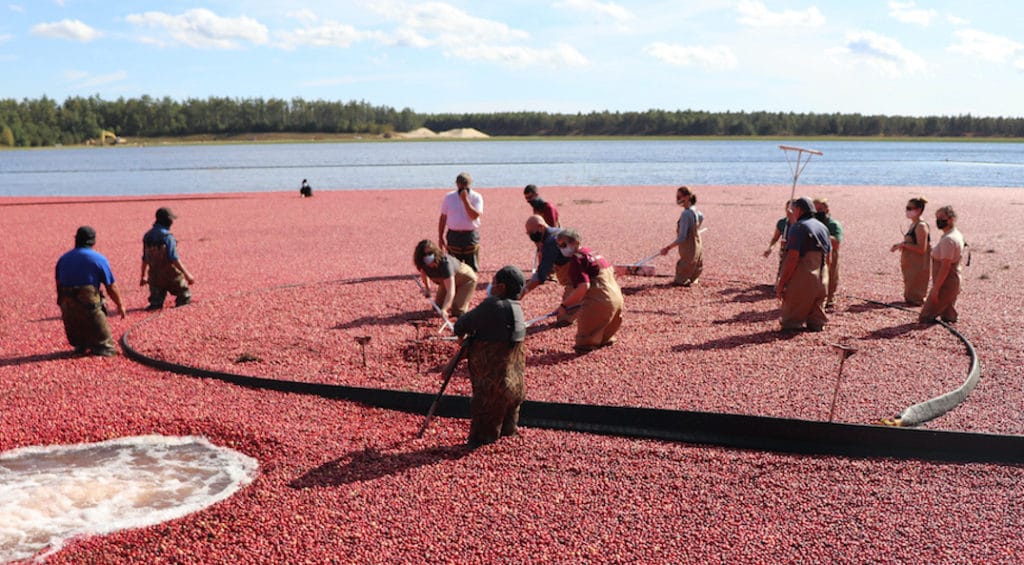
Visitors who come to A. D. Makepeace in Wareham, Massachusettes in autumn are invited to pull on water-proof waders and help in the cranberry harvest.
As you might expect, with the Northeast’s long and fecund coast, seafood festivals are rife. In early October, the annual Chowdafest, in Westport, Connecticut, has public tastings from more than 40 chefs from throughout New England showing off their bisques and classic clam chowders. The Wellfleet, Massachusetts, Oysterfest and the Bowen’s Wharf Seafood Festival in Newport, Rhode Island, both in mid-October, celebrate oysters, quahogs, shrimps, scallops, and more from the bounty of the sea.
But for my money, the true taste and smell of autumn are apples and cinnamon. To be precise, cider doughnuts hot from the oven at the snack shack of Lawrence Farms Orchards in Newburgh, New York. Lawrence Farms is one of many pick-your-own apple orchards open to the public in the Hudson Valley and elsewhere in the Northeast. I’ve been taking my family there every October for three decades to pluck our own Red Delicious, Mutsu, Granny Smith, Jonagold, Northern Spy, Fuji, Rome and other types. My wife, Kathy, says a mix of varieties makes for the best apple pies. From the hillside orchard, we look out over the entire Mid-Hudson Valley, with more hills on the far side of the Hudson River, colors enlivening the landscape as the surrounding forests dissolve into kaleidoscopic yellows, ochers, reds, and oranges.
But even if we couldn’t pick the apples, I’d still go there for my favorite thing of all: visiting the farm’s snack bar for a huge sack full of hot mini cinnamon-apple doughnuts, several large bags of hot fresh popcorn, and steaming cups of hot apple cider. We then repair to a picnic bench alongside the orchard’s vast pond and watch the swans and geese glide across the water’s surface as we gorge on our makeshift banquet, with blue skies above and cool breezes tickling us from across the pond.
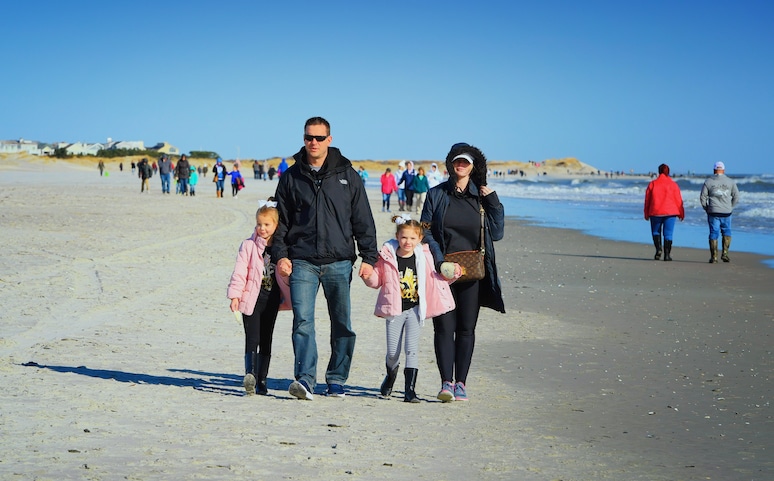
A family strolls along the New Jersey shore in autumn. Photo by Craig Terry/Cape May County Tourism
Earlier, I slandered the misunderstood pumpkin. And as far as it goes, I wasn’t completely wrong. Trying to get their insides outside is a messy, laborious task, full of seeds and stringy muck. The solution? There are food-processing companies that transform pumpkin innards into a smooth, creamy rich paste in a can. With it, my wife bakes wondrous pumpkin pies, cooks scrumptious pumpkin pancakes and bakes the tastiest pumpkin bread in all creation. As I write this, I can smell her pumpkin delicacies. You’ll also find them at the region’s cafés and supermarket bakery departments. But only in the fall.
But the best-loved fall food celebration is Thanksgiving, which, after all, began in the Northeast. Supposedly, the newly arrived Pilgrim immigrants in Massachusetts, following a bountiful harvest in the fall of 1621, celebrated their good fortune with a feast shared with the local Native Americans. Apocryphal or not, we continue celebrating our good fortune and offering our gratitude to this day on the fourth Thursday of November.
If you ever visit the Northeast, try to wrangle an invitation to a Thanksgiving meal. You’ll find it to be a bit more raucous, with a lot more relatives, than elsewhere in the United States. The meal often starts early, around 2 or 3 in the afternoon, and goes on until late in the evening. You walk up to a house that’s probably a hundred years old or more; the housing stock in this region is full of charming antique residences. Right away you notice the front-porch decorations: whole pumpkins on the steps, corn stalks tied to a porch column, colorful gourds in a basket next to the front door, handprint turkey drawings from pre-schoolers taped to the windows, and a stray plastic spider or skull accidentally left over from Halloween a few weeks earlier.
Thanksgiving is even more of a family celebration than Christmas, and ranks even higher on the list of many Northeasterners’ favorite holidays. The meal invariably starts with homemade creamed corn and boiled peas, fresh from the shell; hot and steaming baked bread with heaps of butter; mashed sweet potatoes and deviled eggs and green bean salad with red onions. The butter-and-herb roast turkey, accompanied by jelly-like cranberry sauce on the side, follows immediately with refilled glasses of wine and ends with three or four different kinds of pie brought by the visiting families—cherry, apple, pumpkin, blueberry—and gallons of coffee and tea.
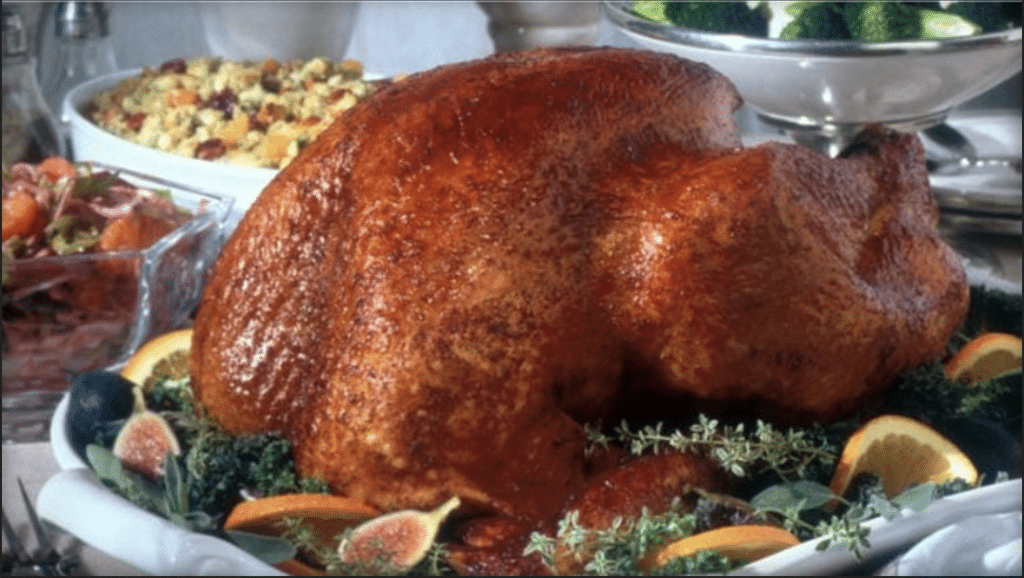
Benjamin Franklin wanted the turkey to be America’s national bird. He thought it a much more useful fowl than the Eagle. Franklin lost that argument. But every Thanksgiving the turkey becomes the national bird at family dinners throughout the country.
In the food coma that usually ensues, we dream about our lives, family unity and our relationships in the community. We share reasons for being thankful and ponder the good times to come before our thoughts inevitably start to drift.
Just as man so often anthropomorphizes animals, so too do we give human characteristics to the seasons—and nowhere in the United States are seasons as distinct as they are in the Northeast. Spring means rebirth, a new start and baseball. Summer is our glorious youth, with endless possibilities. Fall is the beginning of the end of things. And winter is death and closure. A friend, not from the Northeast, recently asked me if autumn here is a sad time. My answer? Not sad, exactly. Melancholy? Perhaps. Wistful? That’s closer to the mark. Some examples of what I mean…
I dare you to stand at the base of the Delaware Water Gap, where the roaring and wild Delaware River rushes between Mount Minsi in Pennsylvania and Mount Tammany in New Jersey, on a cold and gray October morning and not contemplate your mortal existence and what it all means.
Or drive out to the Montauk Lighthouse on the eastern tip of Long Island on a chilly November afternoon. Raked by the salt spray, the yellow-brown bluffs bring to mind the white cliffs of Dover, and nothing stands between you and Land’s End in Cornwall, England, except 3,150 miles of untamed, unknowable ocean. Tell me it doesn’t make you a little thoughtful.
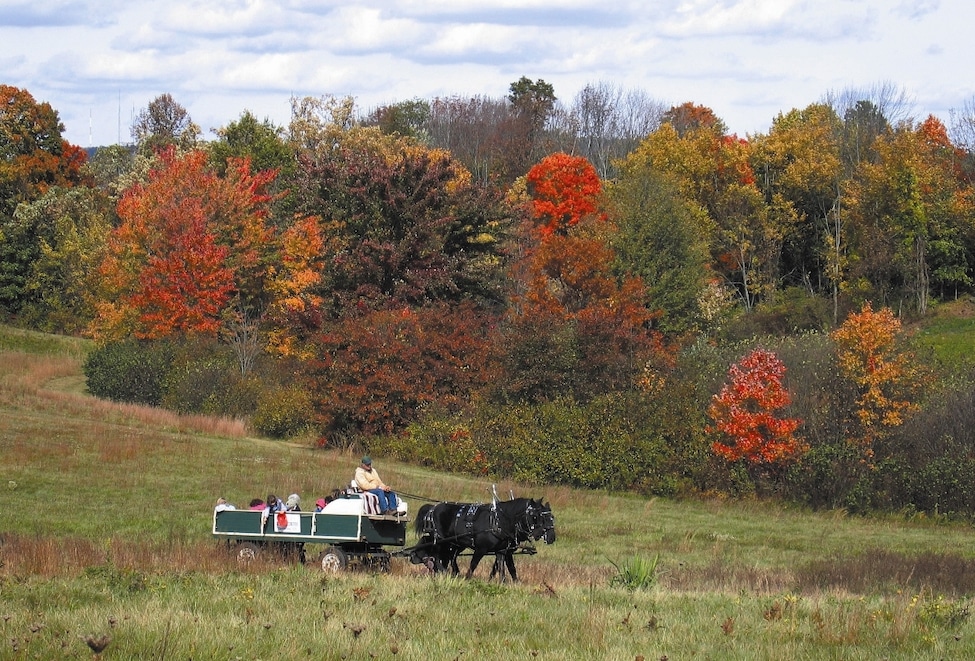
Visitors to the Hill-Stead Museum in Farmington, Connecticut can enjoy the fall colors from horse-drawn hay wagons. The autumn rides are best enjoyed with a cup of hot apple cider and a protective splash of sunscreen. Photo courtesy of the Connecticut Office of Tourism
Sad? Melancholy? Wistful? I refer you to one of the most moving numbers from the Great American Songbook, “Autumn in New York,” written by Vernon Duke, as performed by the inimitable Frank Sinatra. I first heard that song as a 26-year-old magazine editor newly arrived in Manhattan. I was in a Times Square diner in late October on a somewhat gloomy day when Sinatra’s voice came over the café’s crackly speakers. The words were at once uplifting and, yes, sad. They encapsulated a potful of emotions and thoughts in a few pithy phrases. And if you come to the Northeast in the fall, it’s well worth a listen. To put you in the mood. There’s the promise of new love, the threat of pain, there are lovers, hopeful lovers, in the dark. It’s autumn in New York and the Northeast. It’s good to live it again.![]()
Mark Orwoll, a former International Editor for Travel + Leisure, previously published stories for the East-West News Service on regional desserts, the borough of Queens, NY and traveling U.S. highways in search of America’s spirit.

